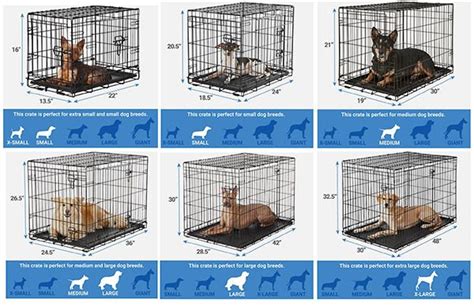Understanding your dog’s size and needs
Understanding your dog’s size and needs is crucial when it comes to providing the best care and accommodations for your furry companion. Every dog is unique, and their size plays a significant role in determining various aspects of their health, behavior, and overall well-being. By understanding these factors, you can ensure that your dog is happy, comfortable, and thriving in their environment.
One of the essential aspects to consider when understanding your dog’s size is their physical needs. Large dog breeds, such as Great Danes or Mastiffs, require more space to move around and exercise compared to smaller breeds like Chihuahuas or Pomeranians. While smaller dogs might be content with regular walks or play sessions in a small yard, larger breeds require ample space to stretch their legs and burn off energy.
Additionally, the size of your dog will also influence their dietary requirements. Larger breeds tend to have a higher metabolism and may require more food compared to smaller breeds. It’s important to consult with your veterinarian to determine the appropriate portion sizes and a balanced diet for your dog’s specific size and breed. Proper nutrition is crucial for maintaining their weight, muscle development, and overall health.
- Regular exercise is vital for all dogs, regardless of their size.
- Smaller breeds, such as toy or miniatures, are well-suited for apartment living where space is limited.
- Large breeds, such as Labradors or Golden Retrievers, thrive in homes with spacious yards where they can freely roam and play.
- Consider your dog’s size when choosing toys or accessories to ensure they are safe and suitable for their breed.
- Remember to monitor your dog’s weight and adjust their portion sizes accordingly to maintain optimal health.
| Small Breeds | Medium Breeds | Large Breeds |
|---|---|---|
| Chihuahua | Cocker Spaniel | Labrador Retriever |
| Maltese | Bulldog | German Shepherd |
| Pomeranian | Beagle | Golden Retriever |
Understanding your dog’s size and needs can greatly contribute to their overall well-being and happiness. By considering their physical requirements, dietary needs, and exercise habits, you can create an environment that caters to their specific size and breed. Whether you have a small, medium, or large dog, providing them with proper care and accommodations will result in a happy and healthy canine companion.
Determining the appropriate crate size
When it comes to choosing the right crate for your dog, determining the appropriate size is crucial. A crate that is too small can make your dog feel cramped and uncomfortable, while a crate that is too big may not provide the security and den-like environment that dogs naturally seek. So, how do you determine the appropriate crate size for your furry friend?
First and foremost, measure your dog to get an accurate idea of their height, length, and weight. This will serve as a good starting point in finding the right-sized crate. It’s important to note that each dog breed has its own unique dimensions, so taking accurate measurements is vital.
Next, it’s recommended to add a few inches to your dog’s measurements. This additional space will allow your dog to comfortably stand up, turn around, and stretch out inside the crate. Remember, the crate should be a cozy retreat for your dog, resembling a den-like space where they can relax and feel secure.
Consider the future growth of your dog as well. If you have a puppy or a young dog that is still growing, it’s advisable to choose a crate size that will accommodate their adult size. This way, you won’t have to invest in a new crate as your furry friend grows. However, if you have an adult dog, selecting a crate based on their current measurements is appropriate.
List of considerations for determining the appropriate crate size:
- Measure your dog accurately (including height, length, and weight).
- Add a few inches to your dog’s measurements for comfort.
- Consider the future growth of your dog, especially if you have a puppy.
In conclusion, determining the appropriate crate size for your dog involves measuring them accurately, adding extra space for comfort, and considering their future growth. By following these guidelines, you can ensure that your dog has a crate that provides the perfect balance of security and space, allowing them to feel safe and comfortable in their new den-like environment.
Considerations for different dog breeds
When it comes to choosing the right crate for your beloved pet, it’s important to consider the specific needs and characteristics of their breed. Different dog breeds have different sizes, temperaments, and energy levels, which can greatly impact their crate requirements. By understanding the considerations for different dog breeds, you can ensure that you provide a comfortable and suitable living space for your furry friend.
One of the key factors to consider is the size of the crate. Small dog breeds such as Chihuahuas or Yorkshire Terriers typically require smaller crates to provide a cozy and secure environment. On the other hand, large dog breeds like German Shepherds or Great Danes need crates that are spacious enough for them to move around comfortably. It’s important to measure your dog’s size and refer to breed standards to determine the appropriate crate dimensions.
Temperament is another crucial consideration. Some breeds, such as Labrador Retrievers or Golden Retrievers, are known for their friendly and sociable nature. These breeds generally do well in open crates that allow them to interact with their surroundings. On the other hand, guardian breeds like Rottweilers or Doberman Pinschers may prefer a more enclosed crate environment that offers them a sense of security and privacy.
Energy levels also play a role in crate selection. High-energy breeds like Border Collies or Australian Shepherds require crates that offer plenty of room for movement and play. A wire crate with good ventilation can be a great option as it allows them to see and engage with their surroundings. However, less active breeds such as Bulldogs or Basset Hounds may prefer a more enclosed and cozy plastic crate that offers a den-like feeling.
In addition to these considerations, it’s important to keep in mind any specific breed needs. For example, some breeds may have a predisposition to certain medical conditions, such as Brachycephalic breeds with their unique respiratory systems. In such cases, a well-ventilated crate with ample airflow is crucial for their comfort and well-being.
List of Considerations for Different Dog Breeds:
- Size
- Temperament
- Energy levels
- Specific breed needs
Comparison Table of Crate Recommendations:
| Breed | Recommended Crate Type |
|---|---|
| Chihuahua | Small plastic crate |
| Labrador Retriever | Open wire crate |
| Rottweiler | Enclosed plastic crate |
| Border Collie | Large wire crate |
| Bulldog | Cozy enclosed plastic crate |
Remember, every dog is unique, and what works for one breed may not necessarily work for another. It’s essential to consider your dog’s individual needs, size, temperament, energy levels, and any specific breed requirements when selecting a crate. By taking these considerations into account, you can provide your furry companion with a safe, comfortable, and stress-free environment they can truly call their own.
Exploring different crate materials
When it comes to choosing a crate for your beloved furry friend, one important factor to consider is the material of the crate. The material plays a crucial role in determining the durability, comfort, and overall suitability of the crate for your dog. Let’s explore the different crate materials available in the market.
1. Plastic Crates: Plastic crates are a popular choice among dog owners for several reasons. Firstly, they are lightweight, making them easy to transport and travel-friendly. Plastic crates also provide a sense of security and enclosed space for dogs who prefer cozy, den-like environments. Moreover, plastic crates are easy to clean and maintain, as they can be wiped down with a damp cloth or sprayed with a pet-safe disinfectant.
2. Wire Crates: Wire crates are another common option for dog owners. These crates offer excellent ventilation and visibility, allowing your dog to feel connected to their surroundings. Wire crates are also collapsible, making them convenient for storage and transportation. Furthermore, most wire crates come with removable tray bottoms, which simplifies the cleaning process.
3. Wooden Crates: For dog owners who prefer a more aesthetically pleasing crate, wooden crates are a great choice. These crates are typically made of sturdy wood and often resemble furniture, blending seamlessly with your home decor. Wooden crates offer a sense of privacy and can be more visually appealing compared to plastic or wire counterparts. However, it’s crucial to ensure that wooden crates are well-ventilated and provide adequate airflow for your dog’s comfort.
When selecting a crate material, it’s vital to consider your dog’s specific needs, behavior, and preferences. Some dogs may feel more comfortable in a cozy plastic crate, while others may prefer the openness and visibility provided by a wire crate. Additionally, factors such as portability, ease of cleaning, and the overall durability of the crate should also be taken into account.
Choosing between wire and plastic crates
When it comes to choosing a crate for your furry friend, one of the most important decisions you’ll need to make is whether to go with a wire crate or a plastic crate. Both options have their pros and cons, so it’s crucial to consider your dog’s specific needs and your own preferences. Let’s take a closer look at the features and benefits of each type to help you make an informed decision.
Wire Crates:
Wire crates are a popular choice for many dog owners due to their durability and visibility. These crates are typically made of metal wires that are welded or interwoven to form a sturdy structure. One of the biggest advantages of wire crates is their excellent ventilation, which allows for good airflow and keeps your dog cool and comfortable. The open design also provides your pup with a clear view of their surroundings, which can help alleviate anxiety and make them feel more secure.
Another advantage of wire crates is their versatility. Many wire crates come with divider panels that allow you to adjust the crate’s size as your puppy grows, making it a cost-effective choice for growing dogs. Wire crates are also collapsible, making them easy to transport and store when not in use. Additionally, wire crates are generally easier to clean compared to plastic crates since they have fewer crevices for dirt and odors to accumulate.
Plastic Crates:
Plastic crates, also known as travel crates or airline crates, are a popular choice for pet owners who frequently travel with their dogs. These crates are made of sturdy plastic materials and are usually equipped with a metal or plastic door for easy access. One of the significant advantages of plastic crates is their durability and strength. They are designed to withstand the rigors of travel and provide a secure and cozy environment for your pet.
Another benefit of plastic crates is their ability to provide a den-like atmosphere for your dog. The enclosed design offers a sense of security and privacy, which can be especially comforting for dogs that are anxious or easily stressed. Plastic crates also have a smooth and solid surface, making them relatively easy to clean and disinfect.
In conclusion, the choice between a wire crate and a plastic crate ultimately depends on your dog’s specific needs and your own preferences. If you’re looking for excellent ventilation, visibility, and versatility, a wire crate may be the best option for you. On the other hand, if you often travel with your dog and prioritize durability and a den-like atmosphere, a plastic crate might be the better choice. Consider the size, temperament, and behavior of your furry friend, as well as your lifestyle and transportation needs, to make the right decision.
Evaluating the crate’s functionality and features
When it comes to choosing the perfect crate for your furry friend, it’s important to carefully evaluate the crate’s functionality and features. A crate is not just a simple enclosure for your dog; it serves as their personal space and can greatly influence their behavior and overall well-being. In this article, we will explore the key aspects to consider when evaluating a crate’s functionality and features, ensuring that you make the best choice for your beloved pet.
1. Size and Space: The size of the crate is crucial for your dog’s comfort. It should be spacious enough for them to stand, turn around, and stretch out fully. Additionally, consider the height of the crate, especially if you have a tall breed. Your dog should have ample headroom to prevent any feelings of confinement or discomfort.
2. Easy to Clean: Dogs can sometimes have accidents inside their crates, so it’s vital to choose a crate that is easy to clean. Look for crates with removable trays or easily washable materials. This feature not only ensures hygiene but also makes your life as a pet owner much easier.
3. Ventilation: Proper ventilation is essential to keep your dog comfortable and prevent overheating. Look for crates with adequate ventilation, such as mesh windows or ventilation holes. Good airflow will help manage temperature control and provide a pleasant environment for your pet.
4. Durability: Dogs can be quite destructive, especially if they are anxious or have separation anxiety. Therefore, it’s important to choose a crate made from sturdy and durable materials. Crates made from heavy-duty plastics or reinforced steel are excellent choices, as they can withstand chewing or scratching.
5. Portability: If you often travel with your dog or need to move the crate around frequently, portability is a crucial factor. Look for crates that are lightweight, foldable, and equipped with handles for easy transportation. This feature will make it easier for you to take your furry friend along on trips or reposition the crate within your home.
6. Safety Features: The safety of your dog should be a top priority in crate selection. Ensure that the crate has secure and reliable locking mechanisms to prevent any accidental escapes. Additionally, check for any sharp edges or protruding parts that may harm your pet during their time in the crate.
7. Additional Features: Some crates come with additional features that can enhance your dog’s comfort and make the crate more versatile. These can include padded bedding, partitions for crate training, or even wheels for easy movement. Consider your dog’s specific needs and preferences when evaluating these additional features.
In conclusion, evaluating the functionality and features of a crate is vital to ensure your dog’s comfort, safety, and overall well-being. By considering the size, cleanliness, ventilation, durability, portability, safety features, and any additional features, you can make an informed decision and provide your furry friend with the perfect crate that suits their unique needs.
Considering budget and long-term usability
When it comes to choosing a crate for your dog, there are many factors to consider. One important factor is your budget and the long-term usability of the crate. It’s understandable that you may not want to break the bank on a crate, but it’s also important to choose one that will last and provide a comfortable and safe space for your dog.
Firstly, let’s talk about budget. Crates can vary greatly in price, depending on their size, material, and additional features. It’s important to set a budget before you start shopping for a crate, so you have a clear idea of how much you’re willing to spend. Keep in mind that buying a quality crate may require a slightly higher budget, but it’s worth the investment in the long run.
Next, let’s discuss the long-term usability of the crate. As your dog grows, their crate needs may change. It’s important to choose a crate that can accommodate your dog’s size not only now but also in the future. Consider the estimated size and weight of your dog when they reach adulthood. Opting for a crate with adjustable dividers can be a smart choice as it allows you to modify the space as your dog grows.
Additionally, the durability and quality of the crate play a significant role in its long-term usability. Look for crates made of sturdy materials such as heavy-duty metal or high-density plastic. These materials are more likely to withstand wear and tear over time. It’s also worth checking customer reviews and ratings of the crate you’re considering, as this can give you insight into its durability and overall performance.
In conclusion, when considering budget and long-term usability, it’s essential to strike a balance between affordability and quality. Investing in a quality crate may require a slightly higher budget initially, but it will provide a safe and comfortable space for your dog for years to come. Remember to factor in your dog’s current and estimated size, as well as the durability of the crate when making your decision. By carefully evaluating your options, you can choose a crate that meets both your budgetary constraints and your dog’s long-term needs.
Frequently Asked Questions
What factors should I consider when determining the appropriate crate size for my dog?
When determining the appropriate crate size for your dog, you should consider their adult size, weight, and height. It’s important to choose a crate that allows your dog to stand, turn around, and lie down comfortably.
Are there any specific considerations I should keep in mind for different dog breeds?
Yes, different dog breeds have different physical characteristics and needs. For example, larger breeds may require a stronger, sturdier crate, while smaller breeds may be more comfortable in a cozy, enclosed crate.
What are the different materials available for dog crates?
There are various materials available for dog crates, including wire, plastic, and even fabric. Each material has its own advantages and disadvantages, so consider your dog’s needs and your preferences when choosing.
What are the pros and cons of wire crates?
Wire crates are typically lightweight, easy to clean, and provide excellent airflow for your dog. However, they may not offer as much privacy or security as other types of crates, and their wire construction might not be suitable for all dogs.
What are the pros and cons of plastic crates?
Plastic crates are often more enclosed and provide a sense of security for your dog. They’re also durable and can be easier to travel with. However, they may not offer as much ventilation or visibility for your dog.
What should I look for in terms of functionality and features when choosing a crate?
When choosing a crate, consider features such as a removable tray for easy cleaning, secure latches or locks, and collapsible or foldable designs for convenient storage. Some crates may also have optional dividers for adjusting the space as your puppy grows.
How should I consider my budget and the long-term usability of a crate?
It’s important to consider your budget when choosing a crate, but also think about the long-term usability. Investing in a high-quality crate that suits your dog’s needs can be a worthwhile investment, considering it will last longer and provide better comfort and security for your furry friend.





